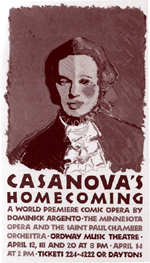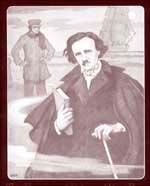Minnesota Romantic | Operas | Song Cycles | Choral Works | Orchestral | The Teacher/Composer | Timeline Part 2: Operas
While some were speculating that the 20th Century had no place for opera, Argento held steadfast in his belief in the genre. The opera companies flourishing since the 1980s (bolstered by supertitles and television broadcasts) have vindicated his loyalty. Although several Argento operas explore his hallmark theme of self-discovery, no two are alike. Indeed, their diversity is astonishing. The most performed is the 1971 Postcard from Morocco, a surreal fantasy consisting of entertainments—a virtuosic display of aria types—in which a group of travelers in a waiting room keep their secrets hidden in their luggage. A paragon of eclecticism, mildly dissonant and with tunes of enduring appeal, the score incorporates a fragment of Wagner's The Flying Dutchman, an instance of musical allusion characteristic of his style. Many Argento works boast strong connections to the past: Casanova's Homecoming, produced in celebration of the new Ordway Music Theatre, abounds with the spirited ensembles typical of its 18th-century Italian model, the opera buffa. Act I incorporates a musical tour de force, offering as a diversion an opera seria that Casanova might have heard in the Venice of his day. Similarly, Argento retreats to the bel canto idiom of 1835 when, in The Aspern Papers, a passage of the hero's lost opera is introduced. Argento is at his grandest in the darkly romantic Voyage of Edgar Allen Poe (1976), commissioned by the University of Minnesota for the 1976 Bicentennial and selected in 1990 by the Lyric Opera of Chicago to launch its series of revivals, "Toward the list Century." With powerful choruses and the continuous commentary of a large orchestra, Argento presents the spectacle of the poet's last nightmarish days.
In the diary Argento kept during the opera's genesis, he contemplates the end of Poe, musing that he wanted to win compassion for the poet: "a lump-in-the-throat" welling up of sympathy for the pitiful life Poe led. As in A Water Bird Talk, which gradually shifts its comic tone to genuine pathos, Argento summons the emotional response of the listener to revelations of the heart. In this, he is the descendant of Verdi, whose portrait hangs on the wall of his study overlooking Kenwood Park. Of Argento's 13 operas, it is Poe that is most suited to the scale and grandeur of the Metropolitan Opera. But that house, so far, has eluded him.
|
|||||||||||||||||||
MPR Home | News | Music Collection | Events | Radio Listening | Your Voice | About Us | Support Us | Help ©2005 Minnesota Public Radio | Terms of Use | Privacy Policy |

